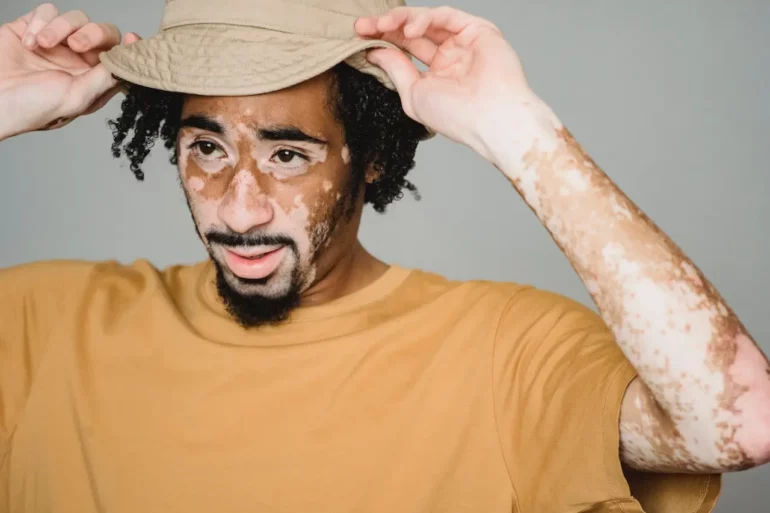Skin disorders largely differ in symptoms and acuteness. They can be painless or painful and may be temporary or permanent. Certain skin conditions are minor, and others can be life-threatening.
A few skin disorders have genetic causes, while others may be situational. Though maximum skin disorders are minor, others could be symptoms of a more serious issue.
The most common are as follows-
- Cold Sore
- This condition leads to a red, painful, fluid-filled blister that’s visible close to the mouth and lips. People with lighter skin may observe more redness compared to those with darker skin.
- The affected area will mostly tingle or burn before the sore can be traced.
- Outbreaks may be accompanied by mild, flu-like symptoms as well, like body aches, low fever, and swollen lymph nodes.
- Generally, cold sores appear similar on any skin color. However, they can also cause PIH among people with darker skin.
- Acne
- Usually, acne is located on the face, shoulders, neck, chest, and upper back.
- Breakouts on the skin are caused due to whiteheads, blackheads, redness, pimples, or deep, painful cysts and nodules.
- If untreated, this condition may leave scars or darken the skin.
- Colored people can experience dark spots called post-inflammatory hyperpigmentation (PIH).
- Hives
- This may lead to itchy, raised welts that happen after being exposed to an allergen.
- Welts could be warm and a bit painful to the touch.
- Hives on darker skin may seem raised or inflamed and could be a bit darker or lighter compared to your natural skin color. On lighter skin, hives normally seem red.
- They can be round, small, ring-shaped, or randomly shaped.
- Blister
- The main features of blisters are a watery, clear, fluid-filled area on the skin.
- They could be tinier than 1 centimeter (cm) (vesicle) or bigger than 1 cm (bulla) and may occur alone or in groups.
- Blisters could be seen anywhere on the body.
- Rosacea
- This chronic skin disease endures a lot of cycles of fading and relapse.
- Relapses may be activated by alcoholic beverages, spicy foods, stress, sunlight, and the intestinal bacteria Helicobacter pylori.
- Four subtypes of rosacea encompass a wide range of symptoms.
- The commonest symptoms are raised red bumps, facial flushing, skin dryness, and skin sensitivity.
- People with darker skin tones may notice brown discoloration or dry and swollen patches of dark skin.
- Actinic Keratosis
- This condition leads to a thick, scaly, or crusty skin patch.
- Usually, it’s less than 2 cm or almost the size of a pencil eraser.
- It mostly appears on parts of the body that are exposed to the sun a lot, like arms, hands, scalp, face, and neck.
- Generally, the skin patch is pink in color. However, it may have a brown, tan, or gray base. This patch may seem to be the same color as the surrounding skin among people with darker skin.
- Latex Allergy
This condition is a medical emergency where urgent care may be necessary. Contact 911 or local emergency services.
- This leads to a rash, which may happen within minutes to hours after being exposed to a latex product. It could be less noticeable on darker skin or may seem lighter or darker compared to the surrounding tissue.
- It also leads to warm, itchy wheals at the site of contact, which may appear dry and crusted due to constant exposure to latex.
- Airborne latex particles may lead to cough, sneezing, runny nose, and itchy, watery eyes.
- An acute allergy to latex may lead to swelling and difficulty breathing.
- Carbuncle
- This leads to a red, painful, and irritated lump under your skin.
- Fever, body aches, and fatigue may accompany it.
- It may lead to skin crustiness or oozing as well.
- It could seem more violet on darker skin.
- Psoriasis
- This leads to silvery, scaly, sharply defined skin patches.
- Darker-skinned people might also endure dark brown or purplish patches on the skin.
- Usually, patches are located on the elbows, scalp, knees, and lower back.
- This condition could be itchy or asymptomatic.
- Eczema
- The main feature of eczema is the yellow or white scaly patches that flake off.
- Affected areas could be greasy, itchy, or oily.
- On light skin, eczema may lead to a red rash, that may seem purple, brown, or gray on darker skin.
- Hair loss may also take place in the area with the rash.
- Measles
- Symptoms of measles are sore throat, fever, red or watery eyes, loss of appetite, cough, and runny nose.
- It may cause a red rash, spreading from the face down the body 3 to 5 days after the appearance of the initial symptoms. This rash could be more difficult to trace on darker skin.
- Small red spots with blue-white centers can appear inside the mouth.
- Measles may lead to more obvious PIH among colored people.
- Cellulitis
Being a medical emergency, a person suffering from cellulitis should contact 911 or local emergency services if they have any symptoms of the same.
- Cellulitis is caused due to bacteria or fungi entering through a crack or cut in the skin.
- It leads to painful swollen skin with or without oozing those spreads faster.
- The skin might seem red on lighter skin. But this could be less noticeable on darker skin tones.
- The skin may appear hot and tender to the touch.
- Fever, chills, and red streaking from the rash could be symptoms of a serious infection necessitating medical attention.
Conclusion Consult a doctor immediately if you have any of the common skin problems mentioned above.



